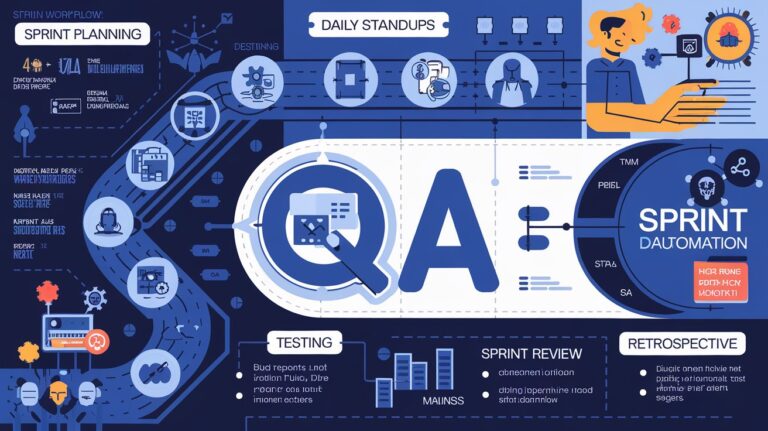The software industry is undergoing a massive transformation—and at the center of it all is test automation. With digital products growing more complex and the demand for faster, more reliable releases, companies are turning to automated testing to streamline quality assurance (QA), eliminate repetitive tasks, and accelerate time-to-market.
This article explores how test automation is changing the game for developers, QA teams, and businesses alike. We’ll cover its benefits, current trends, top tools, use cases, and real-world impact on software development workflows.
Table of Content
What is Test Automation?
Key Benefits of Test Automation
How Automation Fits into Modern Development Workflows
Popular Test Automation Tools in 2025
Current Trends in Test Automation
Real-World Applications of Test Automation
Test Automation vs. Manual Testing: A Balanced Approach
How Test Automation Impacts QA Teams
Challenges in Implementing Test Automation
Best Practices for Successful Automation
Final Thoughts: A New Era of Smart QA
What is Test Automation?

Test automation refers to the use of software tools to automatically execute test cases, compare actual outcomes with expected outcomes, and report the results—without human intervention. Unlike manual testing, which is labor-intensive and time-consuming, automated testing can run 24/7, scale with your application, and catch bugs early in the development process.
Common types of automated tests include:
Unit tests
Integration tests
UI/Functional tests
Regression tests
Performance/load tests
Tools like Selenium, Cypress, Playwright, and TestNG have made automation accessible to teams of all sizes, across different tech stacks.
Key Benefits of Test Automation

1. Faster Time to Market
Automated tests run in a fraction of the time it takes to perform them manually. This speed allows developers to push changes more frequently with greater confidence. In DevOps and CI/CD environments, automation is essential for rapid, reliable releases.
2. Improved Test Coverage
With automation, you can run thousands of test cases across multiple browsers, devices, and environments—something nearly impossible with manual testing. This comprehensive coverage helps uncover edge cases and ensures higher product quality.
3. Early Bug Detection
By integrating automated tests into the build process (using CI tools like Jenkins or GitHub Actions), issues can be caught as soon as new code is committed. This shift-left approach reduces costs and effort associated with late-stage bug fixing.
4. Cost Efficiency
Although setting up automation requires an initial investment, the long-term ROI is significant. Automated tests can be reused across versions, saving countless hours and reducing the need for large QA teams focused solely on repetitive manual checks.
5. Consistency and Accuracy
Automated tests eliminate human error in repetitive testing tasks. The scripts perform exactly the same way each time, ensuring reliable and predictable results.
How Automation Fits into Modern Development Workflows

Automation isn’t just a QA tool—it’s a pillar of Agile, DevOps, and CI/CD pipelines. Here’s how it integrates:
Agile Teams use automation for regression and smoke tests within each sprint.
DevOps Practices rely on automated tests for validating builds and deployments.
CI/CD Pipelines run test suites automatically on every code commit or pull request.
This continuous testing approach enables faster iterations, improved code quality, and more frequent releases.
Popular Test Automation Tools in 2025

Here are some widely adopted automation tools being used today:
| Tool | Type | Best For |
|---|---|---|
| Selenium | UI Automation | Cross-browser web app testing |
| Cypress | End-to-End Testing | Modern JavaScript web apps |
| Playwright | UI & Headless Tests | Fast, reliable browser testing |
| JUnit/TestNG | Unit Testing | Java-based backend and APIs |
| Postman/Newman | API Testing | Automated REST API testing |
| Appium | Mobile Automation | Android and iOS app testing |
| Katalon Studio | Low-Code Testing | Teams seeking ease of use |
Each tool comes with its own strengths and is often integrated with CI/CD tools like Jenkins, GitHub Actions, CircleCI, and Azure DevOps.
Current Trends in Test Automation

1. AI-Powered Testing
Artificial intelligence and machine learning are being integrated into testing tools to auto-generate test cases, identify flaky tests, and prioritize test execution based on risk and code changes.
2. Shift-Left and Shift-Right Testing
Shift-left encourages testing earlier in development, while shift-right introduces automation in production environments for real-time monitoring and validation.
3. TestOps & QAOps
Blending DevOps and testing, these methodologies focus on bringing test execution, environment management, and result analysis into a fully automated, centralized workflow.
4. Scriptless Test Automation
No-code and low-code automation platforms are gaining popularity as they empower non-technical QA teams to create and manage test cases visually—without writing scripts.
5. Cloud-Based Testing
Testing in the cloud allows for distributed test execution, device/browser coverage at scale, and integration with SaaS-based CI/CD platforms.
Real-World Applications of Test Automation

Here are a few ways businesses are applying test automation in practice:
E-commerce: Run nightly UI tests to ensure all cart, checkout, and payment features work across devices and regions.
Banking/Fintech: Use API and regression testing to secure transactions, user data, and compliance workflows.
SaaS Platforms: Integrate test automation into CI/CD pipelines to deploy weekly or even daily without fear.
Mobile Apps: Automate functional tests for Android/iOS using Appium or Firebase Test Lab.
Test Automation vs. Manual Testing: A Balanced Approach

Despite its benefits, test automation is not a silver bullet. Manual testing is still valuable for:
Exploratory testing
UI/UX assessments
Tests that change frequently or are hard to automate
The best teams adopt a hybrid testing strategy—automating what’s repeatable and relying on human intuition for the rest.
How Test Automation Impacts QA Teams

For QA professionals, automation shifts the focus from pure manual testing to more technical roles like:
Writing automation scripts
Maintaining test frameworks
Analyzing failed test reports
Integrating with CI/CD
Building test data pipelines
This transformation opens up opportunities for testers to evolve into SDETs (Software Development Engineers in Test), QA DevOps, or even Test Architects.
Challenges in Implementing Test Automation

While beneficial, automation does come with challenges:
Initial Setup Costs: Time and effort are needed to build frameworks and train teams.
Test Maintenance: UI changes can break scripts if not designed properly.
Tool Selection: Not every tool fits every team—poor choice can lead to wasted effort.
Flaky Tests: Unreliable tests can result in false positives/negatives, eroding trust.
To succeed, teams need strong leadership, clear automation strategies, and continuous refinement of their test suites.
Best Practices for Successful Automation

Start Small and Scale: Begin with smoke tests or critical user journeys.
Design for Reusability: Build modular scripts to reduce maintenance.
Prioritize Tests: Focus on high-value, stable, and frequently executed scenarios.
Integrate Early: Add automation to your CI/CD pipeline from the start.
Review and Refactor: Regularly update your test cases to align with application changes.
Final Thoughts: A New Era of Smart QA

Test automation has become more than just a tool—it’s a strategic enabler of innovation, speed, and quality in software development. As companies continue to adopt Agile and DevOps, automation will become the glue that binds development and QA into a single, continuous cycle of improvement.
Whether you’re a startup or an enterprise, embracing test automation today ensures you stay competitive tomorrow.














